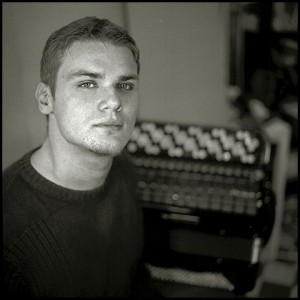 Ivan Šverko majored in classical accordion in 2009 at the University of Juraj Dobrila Pula (Department of music, Class of May art. Borut Zagoranski). He began his studies in the Ivan Matetić Ronjgov school and from an early age he attended seminars and master classes with many of the most important masters of the accordion and concert. Since 2010 he is a student of Professor Mika Väyrynen at the prestigious Sibelius Academy in Helsinki. It is engaged in an activity concerts both in his country and abroad.
Ivan Šverko majored in classical accordion in 2009 at the University of Juraj Dobrila Pula (Department of music, Class of May art. Borut Zagoranski). He began his studies in the Ivan Matetić Ronjgov school and from an early age he attended seminars and master classes with many of the most important masters of the accordion and concert. Since 2010 he is a student of Professor Mika Väyrynen at the prestigious Sibelius Academy in Helsinki. It is engaged in an activity concerts both in his country and abroad.
When did you start playing accordion?
I have started to play accordion in the year of 1995, at the age of nine. It was by accident really. At that time my older sister was just about to start her violin lessons and I didn’t want to be left behind. Therefore, I persuaded my parents into subscribing me for the entry exam at the music school in Pula. Why accordion? Well, since my parents thought it will be a short-lasting hobby, it was the simplest option, since we had a friend’s old accordion at our disposal. Luckily, I had a good teacher who has showed me all the amazing capabilities of our instrument early on. Within a year or two, I was a seriously dedicated accordion student.
What is the immage of accordion in your country?
The accordion tradition is strong in Croatia, particularly on the Istrian Penisula, in the city of Pula. It is a place where a term classical or concert accordion is something which is known for decades, thanks to our accordion pioneer Stanko Mihovilic. Of course, like in many other countries, there are still many people who are unaware of the fact that accordion has evolved and is nowadays a fully-developed instrument present on a concert scene. That being said, it is not a bad situation at the moment. The accordion is finally getting the attention it deserves in our country. It is not uncommon anymore that important music festivals include accordion-related events in their programs. Other instrumentalists, conductors and composers are getting involved in such projects. At the moment, we have one music university where the accordion is being taught in addition to many high-schools across the country. The fact that Croatia has many freshly-graduated and enthusiastic teachers certainly promises.
How changed the image of your instrument since you started playing?
As I mentioned while replying to the previous question, it has gone a long way, both in Croatia and internationally. First time I witnessed a serious accordion festival was on the international competition in Pula (1997.). In the nineties, the level was already rather high. To this date, the level keeps getting better and better – there are many young teachers who were trained specifically as accordionists, which weren’t the case 20 years ago. The accordion curriculums in schools, conservatories and universities keep getting updated as the new methods and didactic materials are being presented. The development of social media such as YouTube has helped immensely to spread the word about our instrument. More and more accordionists collaborate with good musicians of any kind and play in famous venues, even the most known and elitistic, like Carnegie Hall. More and more relevant composers show interest in our instrument. It seems that various accordion manufacturers are also making innovations and improving technical and acoustical properties of our instrument after what has been a certain number of years during which nothing much seemingly happened. All in all, to put the accordion in the place it deserves takes time – it is a long process but I would say we are closer then ever.
Abroad you can confront with many musicians musically and culturally. What is, in your opinion, the most popular music performed with accordion?
It is hard to talk about concrete pieces of music and which one among those is the most appreciated by the classical accordion world – there are so many various approaches and ideals when it comes to the classical accordion and what should its repertoire consist of. Even though there might be some common denominators, many of these schools and traditions completely contradict others. Some deny the artistic value of the older original Russian music for bayan, or romantic transcriptions in general, others frown upon contemporary music, dismissing it right away as ugly or purposeless. In my opinion, the simplest guideline would be to stick with the quality, regardless of the subgenre. Of course, it is up to each individual to decide what is a quality repertoire. I can’t understand musicians who play and teach just the so-called old school accordion music and use notes-per-seconds approach in judging one’s artistic value while shying away from anything innovative but I also disagree that the modern concert accordion recital should be something obscure and incomprehensive, made exclusively of contemporary music which nobody understands. Composing or playing dissonance after dissonance doesn’t make you by default a thoughtful, cryptic, musician who is unfolding the mystery of the Universe before unsuspecting listeners, at least not necessarily. It also works vice versa, it would be good for students and teachers to open themselves to the newly written repertoire, there are many gems hiding there and sticking just with what you have known for years might not be optimal. I believe the truth is somewhere in the middle – classical accordionists can exploit the great versatility of our instrument to their advantage. Why not to be proficient in many genres and styles if the instrument allows for it? Such approach might yield greater flexibility and superior results if the performing career is part of one’s personal goals.
Can you talk about your experience in teaching?
Upon graduating accordion on the University of Juraj Dobrila in the year 2009. I have spent some time working in the music school of Rijeka (Croatia) after which I went to proceed with my postgraduate studies at the Sibelius Academy in Helsinki. Even though I didn’t have enough time to teach regularly while being in Finland, I have still been invited for an occasional master class and seminar. I was also teaching privately. Since this December, I am teaching at the Conservatory Tchaikovsky in Nocera Terinese, Italy. The conservatory has a very large accordion class full of talented and promising students of all ages. It is a big responsibility but also pleasure and challenge to have the opportunity to work with them.
Questo post è disponibile anche in: Italian

 English
English Italiano
Italiano 





Leave a comment
You must be logged in to post a comment.